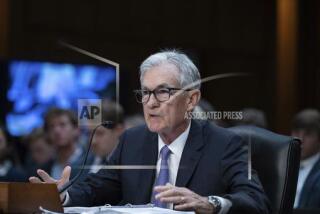Job Growth, Wages Send Mixed Signals
With hiring down and wages up, Friday’s employment report for April sent conflicting signals to the Federal Reserve as it prepares to meet Wednesday to consider another interest rate hike.
The surprisingly weak addition of 138,000 net jobs -- far fewer than the 200,000 expected by economists -- provided the latest evidence that the economy was slowing from its sizzling pace of the first quarter.
That could prompt the Fed to pause sooner rather than later in its credit-tightening campaign against inflation, out of concern that raising rates too high might slow the economy too much.
But strong wage growth -- increasing last month at its highest annual rate in nearly five years -- could put additional pressure on inflation. Businesses could raise prices in response to higher employment costs.
“The job report does present a mixed picture to the Federal Reserve,” said Lynn Reaser, an economist with Bank of America in Boston. “It does suggest that ... inflation pressures may be building. But a softening on the job front suggests the economy is not overheating and may be moderating to a more sustainable track.”
Friday’s brisk stock market rally suggested that investors were buying into the latter notion -- that the economy would suit Goldilocks, not too hot nor too cold, analysts said. The Dow Jones industrial average gained nearly 139 points, while other indexes also rose.
The Fed is expected to boost its benchmark short-term rate by a quarter percentage point to 5% next week -- up from only 1% two years ago. But after that, further hikes are anyone’s guess.
A broad swath of the economy -- including the financial, manufacturing and healthcare sectors -- added jobs last month, the Labor Department said Friday. But unexpected job losses among retailers limited the overall gain to well below the number of jobs created in March, which was revised down by 11,000, to 200,000.
Analysts said it was unclear whether the slowdown was a statistical fluke or the economy was simply backing off the 4.8% annual growth rate of the first quarter toward a more sustainable pace.
Mark Zandi, chief economist at Moody’s Economy.com, said April’s apparent hiring slowdown was way off the trend line and might be a technical error in the way job growth was adjusted to account for a late Easter. Still, it probably reflects where the hiring picture is headed.
“Higher energy prices will start to bite, particularly when they mix in with higher interest rates,” Zandi said. “That will weigh in on growth, and we’ll get a more fundamental slowing in growth by summer and fall.”
But April’s wage report offered no hint of a slowdown. Workers’ average hourly earnings rose to $16.61, up 9 cents, or 0.5%, over March. That increase came on the heels of a 5-cent gain in March and a 7-cent boost in February. For the last year, average hourly earnings rose 3.8%, the highest since August 2001.
The unemployment rate held steady at 4.7%.
Economists said the wage gains helped buoy consumer spending despite rising interest rates and gasoline prices. The wage gains were driven in part by a longer workweek, which rose to 33.9 hours, up from 33.8 in March.
Some analysts said that although the wage gains were overdue, they still were insufficient for working families trying to keep pace with inflation.
“Though wages have clearly been on the rise lately, they are just about back to where they started at the beginning of the recovery,” said Jared Bernstein, senior economist at the liberal Economic Policy Institute.
Citing the job increase and unchanged unemployment rate, President Bush said, “This economy is strong.”
Bush made an unannounced visit Friday to a hardware store in Washington, where he bought a chew toy for one of his Scottish terriers and said, “Small businesses provide most of the job growth in our country. The small business sector is doing well; so is the American economy.”
Manufacturing, a key part of the rebound, added 19,000 jobs in April, the sector’s biggest monthly jump in almost two years. That was the sector’s sixth increase in seven months for an overall gain of 59,000 jobs since September.
But Chi Nguyen, an economist with the National Assn. of Manufacturers, said prospects for more gains depended in part on fuel prices.
“In particular, the continuing high cost of natural gas is putting intense pressure on manufacturing, which uses about one-third of the nation’s natural gas,” Nguyen said.
Employment in construction -- another sector being closely watched amid the specter of a housing slowdown -- was flat for a second month in April after large gains in January and February.
In a report issued Friday, the Fed said Americans moderated their credit card spending in March. Consumer credit rose at an annual rate of 1.4%, down from 2.5% in February and the smallest increase in four months.
Times staff writer James Gerstenzang in Washington contributed to this report.
More to Read
Inside the business of entertainment
The Wide Shot brings you news, analysis and insights on everything from streaming wars to production — and what it all means for the future.
You may occasionally receive promotional content from the Los Angeles Times.










